

Cable
Street
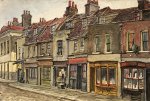 The
rich history of Cable Street [left - as it might have been in the 1830s], with its 'iconic' East End status, has
inspired many writings; see, most recently, Roger Mills Everything Happens in Cable Street (Five Leaves Publications 2011), and other works referrred to below. In 1963, Ian Nairn wrote 'Cable
Street, the whore's retreat': a shameful blot on the moral landscape of
London: an outworn slum area ... Its crime is not that it contains vice
but that it is unashamed and exuberant about it ... Nobody cares enough
and the whole place will soon be a memory.
Fortunately, he has been proved wrong, even though much of its history
is no longer physically visible, there are many who know and care about
the detailed records that are available.
The
rich history of Cable Street [left - as it might have been in the 1830s], with its 'iconic' East End status, has
inspired many writings; see, most recently, Roger Mills Everything Happens in Cable Street (Five Leaves Publications 2011), and other works referrred to below. In 1963, Ian Nairn wrote 'Cable
Street, the whore's retreat': a shameful blot on the moral landscape of
London: an outworn slum area ... Its crime is not that it contains vice
but that it is unashamed and exuberant about it ... Nobody cares enough
and the whole place will soon be a memory.
Fortunately, he has been proved wrong, even though much of its history
is no longer physically visible, there are many who know and care about
the detailed records that are available.
 Cable
Street, running from the Tower of London in the west to Ratcliff in the
east, was originally the standard length of hemp rope, twisted into a
cable, required for sailing ships; there were various rope
walks in the area. In 1695 it was paved from the Windmill Inn to the
junction with Church Street (Anne Steele was among some local residents
who petitioned to be excused from the cost of this work). At one time
each part of the street bore different
names: from west to east, Cable Street, Knockfergus (because of the
many Irish residents), New Road, Back Lane [or Road], Bluegate Fields
[at one time the present-day Dellow Street was also so-named],
Sun Tavern
Fields and Brook Street. In addition, some sections had addresses as St
George's Place, Allington Place, Bath Terrace, Chaurgur Row,
Harper Place, Wellington Place and China Place, as shown on the 1862
map, right (still showing a rope walk). Chaurghur, or Chaur-Ghur, Row was an unusual name; the Edinburgh Review of 1870 included a long article on 'London Topography and Street-nomenclature' which comments The
foreign element in the sea-faring population at the East-end, in the
neighbourhood of the docks, is represented by Jamaica Street, Hong-Kong
Terrace, Chaur-Ghur Row (lately altered to Cable Street), Chin-Chu
Cottages, Bombay Street, and Norway Place; and an obscure thoroughfare
in Shoreditch retains the enviable appellation of the 'Land of Promise'; and it concludes with a call for the removal of pretentious, bombastic and pseudo-rural names - One,
at least, of the evils of an overgrown capital will be removed, when
necessity demands the complete revision of our modern
street-nomenclature.
Cable
Street, running from the Tower of London in the west to Ratcliff in the
east, was originally the standard length of hemp rope, twisted into a
cable, required for sailing ships; there were various rope
walks in the area. In 1695 it was paved from the Windmill Inn to the
junction with Church Street (Anne Steele was among some local residents
who petitioned to be excused from the cost of this work). At one time
each part of the street bore different
names: from west to east, Cable Street, Knockfergus (because of the
many Irish residents), New Road, Back Lane [or Road], Bluegate Fields
[at one time the present-day Dellow Street was also so-named],
Sun Tavern
Fields and Brook Street. In addition, some sections had addresses as St
George's Place, Allington Place, Bath Terrace, Chaurgur Row,
Harper Place, Wellington Place and China Place, as shown on the 1862
map, right (still showing a rope walk). Chaurghur, or Chaur-Ghur, Row was an unusual name; the Edinburgh Review of 1870 included a long article on 'London Topography and Street-nomenclature' which comments The
foreign element in the sea-faring population at the East-end, in the
neighbourhood of the docks, is represented by Jamaica Street, Hong-Kong
Terrace, Chaur-Ghur Row (lately altered to Cable Street), Chin-Chu
Cottages, Bombay Street, and Norway Place; and an obscure thoroughfare
in Shoreditch retains the enviable appellation of the 'Land of Promise'; and it concludes with a call for the removal of pretentious, bombastic and pseudo-rural names - One,
at least, of the evils of an overgrown capital will be removed, when
necessity demands the complete revision of our modern
street-nomenclature.
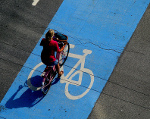
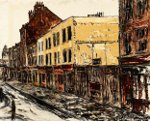
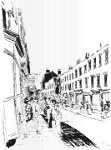 Cable Street was once a busier road than The Highway, until
the latter was widened in recent times and the Limehouse Link tunnel constructed in 1993. It is now a one-way street and
the route of 'CS3', one of the network of Cycle Super Highways
created for the Olympics, and painted blue (rather than the conventional green) because they were
sponsored by Barclay's Bank.
Along Cable Street cycles are separated from motor traffic, but
elsewhere the lanes are narrow strips at the edge of busy roads, and
fatal accidents have raised issues about their safety. See here for more details about public transport in and about the parish. Right is a drawing of Cable Street in the early 1960s from Geoffrey Fletcher Pearly Kingdom (Hutchinson 1965) and a 1970s oil painting by Noel Gibson.
Cable Street was once a busier road than The Highway, until
the latter was widened in recent times and the Limehouse Link tunnel constructed in 1993. It is now a one-way street and
the route of 'CS3', one of the network of Cycle Super Highways
created for the Olympics, and painted blue (rather than the conventional green) because they were
sponsored by Barclay's Bank.
Along Cable Street cycles are separated from motor traffic, but
elsewhere the lanes are narrow strips at the edge of busy roads, and
fatal accidents have raised issues about their safety. See here for more details about public transport in and about the parish. Right is a drawing of Cable Street in the early 1960s from Geoffrey Fletcher Pearly Kingdom (Hutchinson 1965) and a 1970s oil painting by Noel Gibson.
Local
people, having been promised a museum in a converted Cable Street shop
celebrating the achievements of East End women, we horrified to
discover when the frontage was revealed that they have been duped and
it is part of the Jack the Ripper 'industry' - a great pity. More here.
Wilton's Music Hall, Grace's Alley ~ Women's History Museum

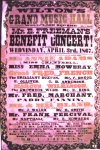
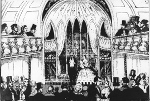
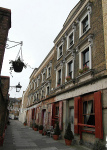

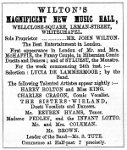 The oldest surviving music
hall in the country (and now a Grade II* listed building, featuring on many websites, including this one), it was built by John
Wilton in 1858 in the back yard of five 1720's houses and incorporating his pub The Prince of Denmark Tavern (named for the Danish links with Wellclose Square) and
its famous mahogany bar. Used for a wide variety of musical and
dramatic events,
it could seat up to 1,800 people, with its barley-sugar pillared
galleries, and had been very successful, competing for a time with West
End theatres. Performers such as Champagne Charlie would speed over
from the West End to give a second performance here. Like other venues,
it promoted 'minstrel' entertainments,
with blacked-up performers, such as Thomas Duriah ('Negro Delineator
and End Man from the London Music Halls') who performed here in 1865.
But it finally failed in the 1870s, as purpose-built venues were
established elsewhere.
The oldest surviving music
hall in the country (and now a Grade II* listed building, featuring on many websites, including this one), it was built by John
Wilton in 1858 in the back yard of five 1720's houses and incorporating his pub The Prince of Denmark Tavern (named for the Danish links with Wellclose Square) and
its famous mahogany bar. Used for a wide variety of musical and
dramatic events,
it could seat up to 1,800 people, with its barley-sugar pillared
galleries, and had been very successful, competing for a time with West
End theatres. Performers such as Champagne Charlie would speed over
from the West End to give a second performance here. Like other venues,
it promoted 'minstrel' entertainments,
with blacked-up performers, such as Thomas Duriah ('Negro Delineator
and End Man from the London Music Halls') who performed here in 1865.
But it finally failed in the 1870s, as purpose-built venues were
established elsewhere.
One
innovation of the London Wesleyan Methodist Mission was to hire
premises as new-style mission
centres - what today
we would call 'fresh expressions' or 'café church'. In 1891 St George's Wesleyan Chapel, further along Cable Street, took over Wilton's, with
leadership from lay church members.
It was known popularly as the 'Old Mahogany Mission' after the bar. Peter Thompson, the minister (who faced a libel action during his
time) was challenged
for allowing the Hall to be used for a dock labourers' meeting to
protest against the 'contracting out' clauses of the Employers
Liability Bill. Interestingly, he did not regard this as a breach of
the Wesleyan 'no politics' rule, despite the dock strike of 1889 (when
2,000 meals a day were served here to strikers and their families); the
Independent Labour Party had only just been founded, and links
between unions and political parties were yet to develop.
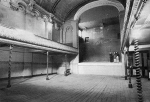
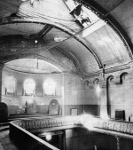 It
was
very different in the 1930s, when Wilton's was a rallying point and a 'safe house' for
the Battle of Cable Street. During the Second World War, it provided refuge for people bombed out of their homes. The
Mission (which had also provided hostel accommodation for 30 people, mainly seafarers)
closed in 1956. In that year, the Rev Lesley E. Day published a pamphlet Sixty-Eight Glorious Years for Christ: the Story of the Old Mahogany Bar (East End Mission). The building was used to store rags [right - interior in the 1970s.]
It
was
very different in the 1930s, when Wilton's was a rallying point and a 'safe house' for
the Battle of Cable Street. During the Second World War, it provided refuge for people bombed out of their homes. The
Mission (which had also provided hostel accommodation for 30 people, mainly seafarers)
closed in 1956. In that year, the Rev Lesley E. Day published a pamphlet Sixty-Eight Glorious Years for Christ: the Story of the Old Mahogany Bar (East End Mission). The building was used to store rags [right - interior in the 1970s.]
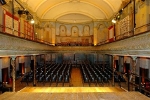

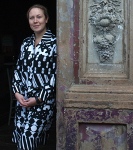 There
were plans for demolition, but Sir John Betjeman was among those who
resisted this. Broomhill
Opera took it on, and among other things staged the first all-black
Carmen, South African mystery plays and a black version of The
Beggar’s Opera. In
its dilapidated state, it was used for film shoots, including Karel
Reisz’s Isadora with Vanessa Redgrave, The Krays (1990), Richard Attenborough's Chaplin (1992), Douglas
McGrath’s Nicholas Nickleby (2002), Woody
Allen’s Cassandra’s Dream, as well as music videos. Opera groups use it
regularly, and it is hired for private functions. It was an
unsuccessful candidate in the 2003 tv series 'Restoration',
but determined
efforts to save and restore the building continue. The bank's threat of
repossession the following year, to recoup debts of £250,000, was
staved off, and under the inspired leadership of Frances Mayhew [right] a
mix of performances, school events and other activities continues, and
the bar is regularly open and makes an excellent venue for small
meetings.
There
were plans for demolition, but Sir John Betjeman was among those who
resisted this. Broomhill
Opera took it on, and among other things staged the first all-black
Carmen, South African mystery plays and a black version of The
Beggar’s Opera. In
its dilapidated state, it was used for film shoots, including Karel
Reisz’s Isadora with Vanessa Redgrave, The Krays (1990), Richard Attenborough's Chaplin (1992), Douglas
McGrath’s Nicholas Nickleby (2002), Woody
Allen’s Cassandra’s Dream, as well as music videos. Opera groups use it
regularly, and it is hired for private functions. It was an
unsuccessful candidate in the 2003 tv series 'Restoration',
but determined
efforts to save and restore the building continue. The bank's threat of
repossession the following year, to recoup debts of £250,000, was
staved off, and under the inspired leadership of Frances Mayhew [right] a
mix of performances, school events and other activities continues, and
the bar is regularly open and makes an excellent venue for small
meetings.
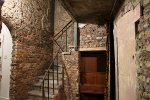
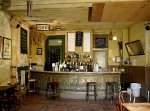
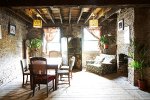
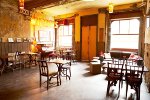 Welcome news came in June 2013, with a grant from the Heritage Lottery
Fund (for which an the appeal was launched by David Suchet in 2011) of £1.85m towards
the £2.6m needed for full-scale restoration. Work due to be completed
in 2015 will secure its fragile structure, and make 40% more of the
building available for new uses as an arts and heritage venue (see East End Life issue 965). Right are four internal views, including the famous bar. Wilton's website is here. When the main auditorium was re-opened in 2013, one of the first productions was a splendid revival of Bill Owen's musical The Matchgirls, first
produced in 1988 to mark the centenary of the heroic first women's
strike by the workers at Bryant and May's factory in Bow (ironically,
the owners were Quakers). A former member of our congregation appeared
in a production three years later, produced by his son Tom Owen, at the
Queen's Theatre Hornchurch. See more about the matchgirls here.
Welcome news came in June 2013, with a grant from the Heritage Lottery
Fund (for which an the appeal was launched by David Suchet in 2011) of £1.85m towards
the £2.6m needed for full-scale restoration. Work due to be completed
in 2015 will secure its fragile structure, and make 40% more of the
building available for new uses as an arts and heritage venue (see East End Life issue 965). Right are four internal views, including the famous bar. Wilton's website is here. When the main auditorium was re-opened in 2013, one of the first productions was a splendid revival of Bill Owen's musical The Matchgirls, first
produced in 1988 to mark the centenary of the heroic first women's
strike by the workers at Bryant and May's factory in Bow (ironically,
the owners were Quakers). A former member of our congregation appeared
in a production three years later, produced by his son Tom Owen, at the
Queen's Theatre Hornchurch. See more about the matchgirls here.
Round
the corner from Wiltons, there are plans to develop no.12 Cable Street
into a Women's History Museum, focusing particularly on women of the
East End.
The birth of Harrods
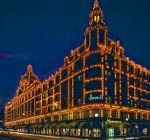
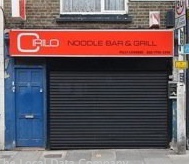 4
Cable Street is an unlikely setting for the origins of the famous West
End emporium, but in 1834 Charles Henry Harrod, aged 35, set up a
wholesale grocery and tea merchant's store here, living nearby in
Rosemary Lane. It remained here probably until 1855, by which time he
had another branch at Eastcheap, and began the move to Knightsbridge in
1863. (Most department stores began as drapers' shops.) It was his
son Charles Digby Harrod who began the expansion in the 1860s, and the
rest is history!
4
Cable Street is an unlikely setting for the origins of the famous West
End emporium, but in 1834 Charles Henry Harrod, aged 35, set up a
wholesale grocery and tea merchant's store here, living nearby in
Rosemary Lane. It remained here probably until 1855, by which time he
had another branch at Eastcheap, and began the move to Knightsbridge in
1863. (Most department stores began as drapers' shops.) It was his
son Charles Digby Harrod who began the expansion in the 1860s, and the
rest is history!
The site is now a noodle bar and
grill [left]. From
the 1830s until the end of the 19th century, Harrod's Court was a small
alley running from the south-west corner of Wellclose Square into Well
Street [now Ensign Street], though Weller's map of 1868 lists it as
Hard's Place, and another source as Harrald's Place, so the connection
with the family is uncertain.
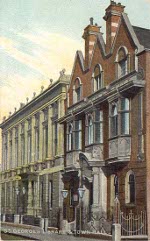
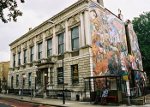
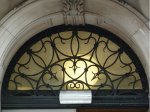 When the
1855 Metropolis
Management Act
created
a new system of local government for London, with an elected Vestry for
each parish, a Vestry Hall was built in 1861 to serve the parish of St
George-in-the-East. It is of Portland stone, with an Italianate façade [left: old postcard, with Library still standing; today, showing the mural; right, fanlight], at a cost of
£6,000, and had a handsome interior. The Buildings of England (London 5: East), by Bridget Cherry, Charles O'Brian and Nicolaus Pevsner (Yale UP 2005) comments on public offices of this time: Most
buildings date from the 1860s onwards and are eclectic, often crude
interpretations of the polite civic architecture of the mid C19
metropolis: St George's, Cable Street, is the earliest, of 1860 by
Andrew Wilson, emulating the solid Italianate popularized by Charles
Barry's Travellers Club in the 1840s. Wilson was the son of Joshua Wilson,
builder and warden of St George-in-the-East in 1854-55, with whom he
had been in partnership before he became an architect, with an office
at 34 Cannon Street Road prior to moving to Bow.
When the
1855 Metropolis
Management Act
created
a new system of local government for London, with an elected Vestry for
each parish, a Vestry Hall was built in 1861 to serve the parish of St
George-in-the-East. It is of Portland stone, with an Italianate façade [left: old postcard, with Library still standing; today, showing the mural; right, fanlight], at a cost of
£6,000, and had a handsome interior. The Buildings of England (London 5: East), by Bridget Cherry, Charles O'Brian and Nicolaus Pevsner (Yale UP 2005) comments on public offices of this time: Most
buildings date from the 1860s onwards and are eclectic, often crude
interpretations of the polite civic architecture of the mid C19
metropolis: St George's, Cable Street, is the earliest, of 1860 by
Andrew Wilson, emulating the solid Italianate popularized by Charles
Barry's Travellers Club in the 1840s. Wilson was the son of Joshua Wilson,
builder and warden of St George-in-the-East in 1854-55, with whom he
had been in partnership before he became an architect, with an office
at 34 Cannon Street Road prior to moving to Bow.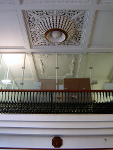
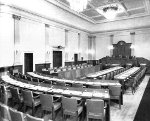 Further local government reform came with the
1899 London
Government Act
which replaced all the Vestries across London with 28 Borough Councils.
The new Stepney Borough
Council took over the building as a local Town Hall until a new one
could be built, and the coroner's court was located there.
Further local government reform came with the
1899 London
Government Act
which replaced all the Vestries across London with 28 Borough Councils.
The new Stepney Borough
Council took over the building as a local Town Hall until a new one
could be built, and the coroner's court was located there. 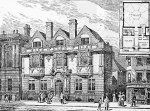
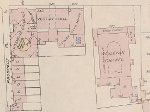 The
Vestry was keen to build a public library, but only had power to raise
1d. on the rates, yielding £600 for the running costs. Public donations
were sought, and John
Passmore Edwards,
the 'Cornish Carnegie', made a major contribution. (He also funded the
Passmore Edwards Sailors' Palace, on West India Dock Road, for the
British and Foreign Sailors Society.) It was
built, in Portland stone and
brick, to the right of the Town Hall [left - drawing
of 1898],
running down the side of Prospect [now Library] Place. Goad's 1899 insurance map - right - shows the adjacent Library, Vestry Hall (under extension at the time) and Wesleyan Chapel. The foundation
stone was laid on 28 September 1897,
and Lord Russell, the Lord Chief Justice, opened it in October 1898. A
children's library was added in 1929.
The
Vestry was keen to build a public library, but only had power to raise
1d. on the rates, yielding £600 for the running costs. Public donations
were sought, and John
Passmore Edwards,
the 'Cornish Carnegie', made a major contribution. (He also funded the
Passmore Edwards Sailors' Palace, on West India Dock Road, for the
British and Foreign Sailors Society.) It was
built, in Portland stone and
brick, to the right of the Town Hall [left - drawing
of 1898],
running down the side of Prospect [now Library] Place. Goad's 1899 insurance map - right - shows the adjacent Library, Vestry Hall (under extension at the time) and Wesleyan Chapel. The foundation
stone was laid on 28 September 1897,
and Lord Russell, the Lord Chief Justice, opened it in October 1898. A
children's library was added in 1929.
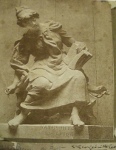
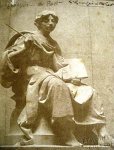 Passmore Edwards also gave two stone sculptures, representing Literature and Art [left],
which were set on either side of the curved pediment of the porch which
was flanked by massive Ionic columns. They were the work of Nathaniel
Hitch
(1845-1938), who had trained with the architectural sculptors
Farmer & Brindley and produced a great deal of work for churches
and other buildings for the leading architects of the day, including
H.P. Burke Downing, H. Fuller Clark, W.D. Caröe, Paul Waterhouse and
T.H. Lyon and particularly John and Frank Loughborough Pearson. His
firm was based at 60 Harleyford Road, Battersea, and his son Frederick
Brook Hitch continued the work. For more on Hitch, including a
forthcoming catalogue of his papers (held at the Henry Moore Archive in
Leeds) by Gordon Lawson, see here.
Passmore Edwards also gave two stone sculptures, representing Literature and Art [left],
which were set on either side of the curved pediment of the porch which
was flanked by massive Ionic columns. They were the work of Nathaniel
Hitch
(1845-1938), who had trained with the architectural sculptors
Farmer & Brindley and produced a great deal of work for churches
and other buildings for the leading architects of the day, including
H.P. Burke Downing, H. Fuller Clark, W.D. Caröe, Paul Waterhouse and
T.H. Lyon and particularly John and Frank Loughborough Pearson. His
firm was based at 60 Harleyford Road, Battersea, and his son Frederick
Brook Hitch continued the work. For more on Hitch, including a
forthcoming catalogue of his papers (held at the Henry Moore Archive in
Leeds) by Gordon Lawson, see here.
The
library was destroyed in the Blitz in 1941. (The sculptures - minus
their heads - can be discerned in photographs following the bomb damage.) A temporary building
in St George's Gardens was later provided, until a new library was
constructed in Watney Street in the 1960s. The site now forms the entrance to St George's Gardens.
 On
the wall of the Library (now on the front of the Town Hall) a small plaque was affixed to commemorate
those who fought and died in the International Brigade, supporting the
anti-fascist forces in the Spanish Civil War against General Franco,
who was supported by Hitler and Mussolini. The rallying-cry was no pasaran - 'they
shall not pass'. Their action inspired Ernest Hemingway's For
Whom the Bell Tolls,
and
the bombing of villages by Nazi aircraft prompted Picasso's Guernica. See here for the former Britannia Arms in Library Place.
On
the wall of the Library (now on the front of the Town Hall) a small plaque was affixed to commemorate
those who fought and died in the International Brigade, supporting the
anti-fascist forces in the Spanish Civil War against General Franco,
who was supported by Hitler and Mussolini. The rallying-cry was no pasaran - 'they
shall not pass'. Their action inspired Ernest Hemingway's For
Whom the Bell Tolls,
and
the bombing of villages by Nazi aircraft prompted Picasso's Guernica. See here for the former Britannia Arms in Library Place.

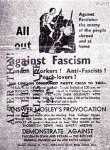

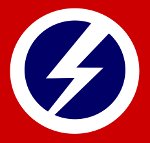
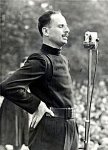
 'They
shall not pass' became
the slogan of those who resisted
the legal
but provocative, and anti-Semitic, march of Sir Oswald Mosley and the
'Blackshirts' - the
British Union of Fascists - through the heavily-Jewish East End on 4
October
1936. Attempts to ban the march had failed, and the police were
there
in force to escort the marchers. Despite the appeals of religious and
political
leaders
to stay away, the marchers were resisted by many thousands from a
diverse range of groups - trade unions, and socialist, communist and
anarchist organisations (see here
for the part played by Fr Groser and the Stepney Tenants Defence
League), though many came from outside too. According to a participant Joe Bloomberg the local boys, men and women literally lifted the cobblestones out of the road, and built barricades to stop them marching. It
was a violent conflict, with the main fighting around what was then
known as Gardiner's Corner*, by Aldgate, but barricades were erected at
three points around Cable Street - which is why the plaque [above] is fixed to a wall near the corner of Dock Street. Their resistance succeeded; and the 1936 Public
Order Act was
passed as a result of the disturbances, requiring police permission for marches and banning
the wearing of political uniforms in public.
'They
shall not pass' became
the slogan of those who resisted
the legal
but provocative, and anti-Semitic, march of Sir Oswald Mosley and the
'Blackshirts' - the
British Union of Fascists - through the heavily-Jewish East End on 4
October
1936. Attempts to ban the march had failed, and the police were
there
in force to escort the marchers. Despite the appeals of religious and
political
leaders
to stay away, the marchers were resisted by many thousands from a
diverse range of groups - trade unions, and socialist, communist and
anarchist organisations (see here
for the part played by Fr Groser and the Stepney Tenants Defence
League), though many came from outside too. According to a participant Joe Bloomberg the local boys, men and women literally lifted the cobblestones out of the road, and built barricades to stop them marching. It
was a violent conflict, with the main fighting around what was then
known as Gardiner's Corner*, by Aldgate, but barricades were erected at
three points around Cable Street - which is why the plaque [above] is fixed to a wall near the corner of Dock Street. Their resistance succeeded; and the 1936 Public
Order Act was
passed as a result of the disturbances, requiring police permission for marches and banning
the wearing of political uniforms in public. 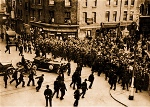
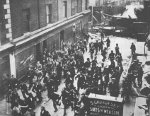

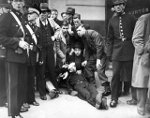


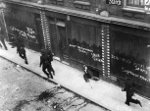
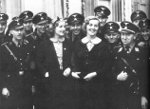
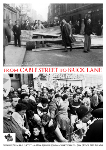
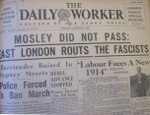 the curious story of the involvement of
'Kid' Lewis, a local Jewish boxer, in Mosley's movement, and his dramatic
resignation
the curious story of the involvement of
'Kid' Lewis, a local Jewish boxer, in Mosley's movement, and his dramatic
resignation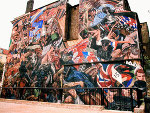
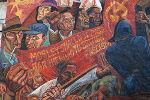
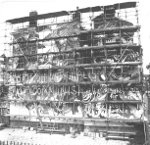
 The mural
The mural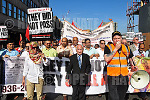
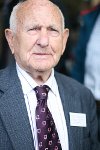 Anniversary commemorations have been held in recent years; here
and here are some pictures of the 70th in 2006. For the 75th anniversary in 2011, a full programme of activities and events was arranged by a various groups and at several venues
- see the programme - and the mural was again restored, by Paul Butler (see this
interview), and an interpretation board added. Events in St George's
Gardens on the Saturday provided a photo-opportunity for the Mayor
and councillors, as well as some excellent performances by amateur and
professional groups. On the Sunday, there was a march with over 1,000
participants from Aldgate to the mural, where speeches were made (it
just managed to escape the 30-day ban on marches imposed to restrict
the English Defence League's attempt to cause trouble in the East End
the previous month, with Muslims rather than Jews as the target),
followed by a programme of events at Wilton's,
culminating in a concert starring Billy Bragg. The range of groups on
the march matched those who had been there in 1936 (plus a few
Bangladeshi groups), and the redoubtable 96-year old Max Levitas [right], formerly a Jewish
communist councillor for Stepney, was a speaker on both days.
Hetty Bower, 106 the following day, and others who were present in
1936, also took part in the march.
Anniversary commemorations have been held in recent years; here
and here are some pictures of the 70th in 2006. For the 75th anniversary in 2011, a full programme of activities and events was arranged by a various groups and at several venues
- see the programme - and the mural was again restored, by Paul Butler (see this
interview), and an interpretation board added. Events in St George's
Gardens on the Saturday provided a photo-opportunity for the Mayor
and councillors, as well as some excellent performances by amateur and
professional groups. On the Sunday, there was a march with over 1,000
participants from Aldgate to the mural, where speeches were made (it
just managed to escape the 30-day ban on marches imposed to restrict
the English Defence League's attempt to cause trouble in the East End
the previous month, with Muslims rather than Jews as the target),
followed by a programme of events at Wilton's,
culminating in a concert starring Billy Bragg. The range of groups on
the march matched those who had been there in 1936 (plus a few
Bangladeshi groups), and the redoubtable 96-year old Max Levitas [right], formerly a Jewish
communist councillor for Stepney, was a speaker on both days.
Hetty Bower, 106 the following day, and others who were present in
1936, also took part in the march.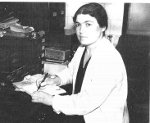
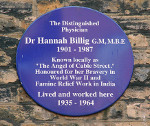
 At 198
Cable Street [now by the entrance to Hawksmoor Mews] there is a plaque to Dr Hannah
Billig, 'the Angel of Cable
Street' - nearby Angel Mews is presumably named for her - who lived and worked here from
1935-64. Four
of the six children of Barnet and Millie Billig, Russian Jewish
emigrés, qualified as
doctors. Hannah has worked at the Jewish
Maternity Hospital before setting up her practice, and in the days
before the NHS turned no-one away because they couldn't pay.
At 198
Cable Street [now by the entrance to Hawksmoor Mews] there is a plaque to Dr Hannah
Billig, 'the Angel of Cable
Street' - nearby Angel Mews is presumably named for her - who lived and worked here from
1935-64. Four
of the six children of Barnet and Millie Billig, Russian Jewish
emigrés, qualified as
doctors. Hannah has worked at the Jewish
Maternity Hospital before setting up her practice, and in the days
before the NHS turned no-one away because they couldn't pay.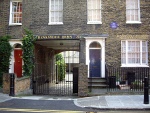
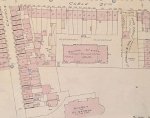

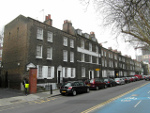 The row of houses between the Town Hall and Cannon
Street Road where her plaque is set (now by the entrance to modern apartments in Hawksmoor
Mews)
was restored in 1978; together with the houses/shops around the corner
in Cannon Street Road, these are the only remaining Georgian properties
in the vicinity of the church. Goad's 1899 insurance map [right] details them, together with the nine houses of Library Place [now demolished] and the school behind, now converted into flats.
The row of houses between the Town Hall and Cannon
Street Road where her plaque is set (now by the entrance to modern apartments in Hawksmoor
Mews)
was restored in 1978; together with the houses/shops around the corner
in Cannon Street Road, these are the only remaining Georgian properties
in the vicinity of the church. Goad's 1899 insurance map [right] details them, together with the nine houses of Library Place [now demolished] and the school behind, now converted into flats. Boxing
was one of the few possible routes to fame for deprived urban boys: see here for the example of 'Johnny Brown' 1902-76; in particular, it was
a channel for the energies of Jewish lads, drawn by anti-Semitic taunts
into street fighting.

 Ted 'Kid' Lewis,
born Gershon Mendeloff to Russian parents in Umberston Street in 1893,
was encouraged by a local policeman to take up training at the Judean
Soul and Athletic (Temperance) Club at 54-56 Prince's Square. By 18, he
was fighting at Premierland in Backchurch Lane (where other Jewish boxers began their careers), Wonderland (off
Whitechapel Road) and the Ring at Blackfriars; he became British
flyweight champion in 1913 (winning the Lonsdale Belt), world
welterweight champion in 1915, and British and European middleweight
champion in 1921, and retired in 1929. Despite earning an estimated
$500,000 in the USA, he was generous and a gambler, so in 1931 he
accepted a job as Oswald Mosley's physical youth training instructor at
£60pw, recruiting local thugs as 'Biff Boys' - Mosley's bodyguard -
until the following year he realised the true, and anti-Semitic, nature
of Mosley's politics, and resigned, knocking Mosley and a couple of his
henchmen across the room. More details here, and in his film producer son Morton Lewis' biography Ted Kid Lewis: His Life and Times
(Robson 1990). From 1966 until his death four years later Lewis lived
at Nightingale House, the Jewish residential and nursing home in
Wandsworth Common (where his blue plaque is) - this had 19th century
roots in Wellclose Square. He was buried at the Jewish Cemetery in East Ham.
Ted 'Kid' Lewis,
born Gershon Mendeloff to Russian parents in Umberston Street in 1893,
was encouraged by a local policeman to take up training at the Judean
Soul and Athletic (Temperance) Club at 54-56 Prince's Square. By 18, he
was fighting at Premierland in Backchurch Lane (where other Jewish boxers began their careers), Wonderland (off
Whitechapel Road) and the Ring at Blackfriars; he became British
flyweight champion in 1913 (winning the Lonsdale Belt), world
welterweight champion in 1915, and British and European middleweight
champion in 1921, and retired in 1929. Despite earning an estimated
$500,000 in the USA, he was generous and a gambler, so in 1931 he
accepted a job as Oswald Mosley's physical youth training instructor at
£60pw, recruiting local thugs as 'Biff Boys' - Mosley's bodyguard -
until the following year he realised the true, and anti-Semitic, nature
of Mosley's politics, and resigned, knocking Mosley and a couple of his
henchmen across the room. More details here, and in his film producer son Morton Lewis' biography Ted Kid Lewis: His Life and Times
(Robson 1990). From 1966 until his death four years later Lewis lived
at Nightingale House, the Jewish residential and nursing home in
Wandsworth Common (where his blue plaque is) - this had 19th century
roots in Wellclose Square. He was buried at the Jewish Cemetery in East Ham.
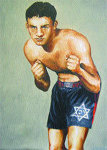 Lewis was the role model for Jack 'Kid' Berg, born Judah
Bergman
in 1909 above a fish shop in Christian Street, off Cable Street. He was
apprenticed as a lather boy in a barber's shop, trained at the Oxford
and St George's Club on Betts Street and began his career at Premierland when
he was 14. He fought
his first professional bout the following year. He first boxed in the
USA in 1928, and was World Junior Welterweight Champion in 1930 -
knocking out a fellow-Jewish boxer at the Albert Hall. He lost the
title the following year, but became British lightweight champion in
1934 (again defeating a fellow-Jew, Harry Mizler). In his career, which
lasted until 1945, when he was 36, he won 157 bouts, drew 9 and lost
26, making him
statistically the most successful world champion Britain ever produced
(today he would have been a 'superstar').
Lewis was the role model for Jack 'Kid' Berg, born Judah
Bergman
in 1909 above a fish shop in Christian Street, off Cable Street. He was
apprenticed as a lather boy in a barber's shop, trained at the Oxford
and St George's Club on Betts Street and began his career at Premierland when
he was 14. He fought
his first professional bout the following year. He first boxed in the
USA in 1928, and was World Junior Welterweight Champion in 1930 -
knocking out a fellow-Jewish boxer at the Albert Hall. He lost the
title the following year, but became British lightweight champion in
1934 (again defeating a fellow-Jew, Harry Mizler). In his career, which
lasted until 1945, when he was 36, he won 157 bouts, drew 9 and lost
26, making him
statistically the most successful world champion Britain ever produced
(today he would have been a 'superstar').
Though from an Orthodox Jewish
family (his parents were emigrants from Odessa and originally opposed his career as a sell-out to goyische midos, or heathen morals), he was not observant, but boxed with a
Star of David on his trunks, and put on tefillin
before his fights, partly to court the Jewish punters - especially when
he was fighting Italian or Irish-American opponents - and
also because he was somewhat superstitious. As one commentator put it, he knew it couldn't hurt to have God on your side.
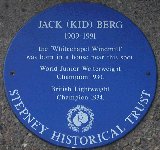 His biography The Whitechapel Windmill (Robson 1987), which he wrote with John Harding, chronicles his rise to fame and
his flamboyant lifestyle, said to have included a fling with Mae West.
During and after his boxing career, he appeared in films - a British silent film Sporting Life in the 1920s, Money Talks (1933) and The Square Ring (1953)
- and was a stuntman in Hollywood and for a Carry On film. A long-term friend was the Jewish East
End gangster Jack Spot. In later
life he was a familiar figure at the ringside and around London in his
red car. His cousin Howard Frederics wrote an opera about his
life, also called The Whitechapel Windmill, which was performed in 2005 under the sponsorship of the Jewish East End Celebration Society.The
blue plaque on Noble Court, Cable Street, near Jack's birthplace, was
unveiled at a ceremony with the Chief Rabbi, the Bishop of Stepney
(Richard Chartres, now Bishop of London), Professor Bill Fishman, Councillor Albert Lille and
the Retired Boxers Federation, followed by a charity ball which raised
over £1000.
His biography The Whitechapel Windmill (Robson 1987), which he wrote with John Harding, chronicles his rise to fame and
his flamboyant lifestyle, said to have included a fling with Mae West.
During and after his boxing career, he appeared in films - a British silent film Sporting Life in the 1920s, Money Talks (1933) and The Square Ring (1953)
- and was a stuntman in Hollywood and for a Carry On film. A long-term friend was the Jewish East
End gangster Jack Spot. In later
life he was a familiar figure at the ringside and around London in his
red car. His cousin Howard Frederics wrote an opera about his
life, also called The Whitechapel Windmill, which was performed in 2005 under the sponsorship of the Jewish East End Celebration Society.The
blue plaque on Noble Court, Cable Street, near Jack's birthplace, was
unveiled at a ceremony with the Chief Rabbi, the Bishop of Stepney
(Richard Chartres, now Bishop of London), Professor Bill Fishman, Councillor Albert Lille and
the Retired Boxers Federation, followed by a charity ball which raised
over £1000.
Elliott Tucker's 2007 film Ghetto Warriors
(viewable online) tells the tale of the phenomenon of the Jewish
boxers of the East End. Other Jewish boxing clubs in the area were Oxford and St George's and 'The Hutch'.
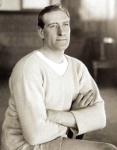
 Among local non-Jewish boxers was (William Thomas) Billy 'Bombadier' Wells
(1889-1967), whose family lived at 250 Cable Street. He left school at
12, worked as a messenger boy and became a Royal Artillery gunner,
rising to the rank of bombadier. He became a professional boxer in 1910
after winning the all-India army boxing championship at Rawalpindi, and
gained and held the heavyweight title for eight years; he never lost on
points and won the first heavyweight Lonsdale belt, boxing until
1925. In 1935 he also became famous as the first gong-striker for
J. Arthur Rank films (though the gong was in fact made of papier-mâché,
and the sound provided by percussionist James Blades striking a 30"
Chinese tam-tam). There have been several others since.
Among local non-Jewish boxers was (William Thomas) Billy 'Bombadier' Wells
(1889-1967), whose family lived at 250 Cable Street. He left school at
12, worked as a messenger boy and became a Royal Artillery gunner,
rising to the rank of bombadier. He became a professional boxer in 1910
after winning the all-India army boxing championship at Rawalpindi, and
gained and held the heavyweight title for eight years; he never lost on
points and won the first heavyweight Lonsdale belt, boxing until
1925. In 1935 he also became famous as the first gong-striker for
J. Arthur Rank films (though the gong was in fact made of papier-mâché,
and the sound provided by percussionist James Blades striking a 30"
Chinese tam-tam). There have been several others since.
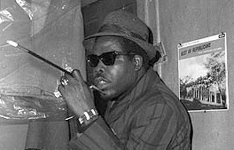
 There is no blue plaque for 'Tex' [self-image left],
but he lived for many years in Cable Street, in a now-demolished house
opposite Noble Court. Born in Nigeria, he settled here in 1949, and as
a talented self-taught photographer chronicled everyday scenes of local
life, especially of black and Asian people, for over three decades - example right -
asking people to stop in the street so that he could take their pictures.
He died in 1994, leaving a vast collection of images, some of
which was showcased at the Spitz Gallery, Commercial Street in 1992.
There is no blue plaque for 'Tex' [self-image left],
but he lived for many years in Cable Street, in a now-demolished house
opposite Noble Court. Born in Nigeria, he settled here in 1949, and as
a talented self-taught photographer chronicled everyday scenes of local
life, especially of black and Asian people, for over three decades - example right -
asking people to stop in the street so that he could take their pictures.
He died in 1994, leaving a vast collection of images, some of
which was showcased at the Spitz Gallery, Commercial Street in 1992. 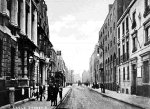
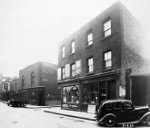
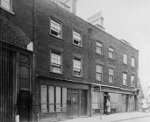
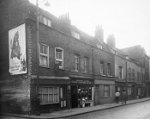
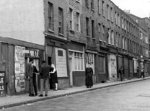
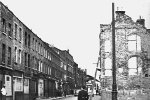
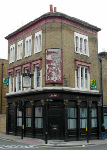
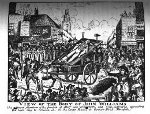
Interment of John Williams, the murdererAt about ten o'clock on Monday night, Mr Robinson, the high constable of the parish of St George, accompanied by Mr. Machin, one of the constables, Mr. Harrison, the collector, and Mr Robinson's deputy, went to the prison at Coldbath-Fields, where the body of Williams being delivered to them, was put into a hackney-coach, in which the deputy-constable proceeded to the watch-house of St George, known by the name of the Round-About, at the bottom of Ship-alley. The other three gentlemen followed in another coach, and about twelve o'clock the body was deposited in the black-hole, where it remained all night.Yesterday morning, about nine o'clock, the high constable, with his attendants, arrived at the watch-house with a cart, that had been fitted up for the purpose of giving the greatest possible degree of exposure to the face and body of Williams. A stage, or platform, was formed upon the cart by boards, which extended from one side to the other. They were fastened to the top, and lapping over each other from the hinder part to the front of the cart, in regular gradation, they formed an inclined plane, on which the body rested, with the head towards the horse, and so much elevated, as to be completely exposed to public view. The body was retained in an extended position by a cord, which, passing beneath the arms, was fastened underneath the boards. On the body was a pair of blue cloth pantaloons, and a white shirt, with the sleeves tucked Up to the elbows, but neither coat or waistcoat. About the neck was the white handkerchief with which Williams put an end to his existence. There were stockings but no shoes upon his feet. The countenance was fresh, and perfectly free from discolouration of livid spots. The hair was rather of a sandy cast, and the whiskers appeared to have been remarkably close shaven. On both the hands were some livid spots. On the right-hand side of the head was fixed, perpendicularly, the maul, with which the murder of the Marrs was committed. On the left also, in a perpendicular position, was fixed the ripping chissel. Above his head was laid, in a transverse direction upon the boards, the iron crow; and parallel with it, the stake destined to be driven through the body. About half past ten, the procession moved from the watch-house, in the following order:Mr Machin, constable of Shadwell.
An immense cavalcade of the inhabitants of the two parishes closed the procession. |
Back to History page | Back to Church & Churchyard | Back to Precinct of Wellclose | Back to Backchurch Lane | Back to Cable Street Directory 1921